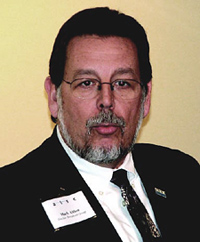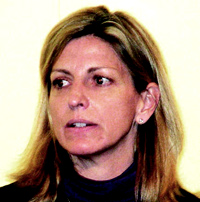TV Prepares for its Mobile Future

Mark Aitken
WASHINGTON
In anticipation of the launch of Mobile DTV consumer tests here next month, more than 100 people from all sectors of the television broadcast industry turned out for the Advanced Television Systems Committee all-day mobile DTV seminar, Feb. 3. Some traveled from as far away as Europe and the Far East to attend.
The seminar was the first such gathering of broadcasters, manufacturers, service providers and others since the formal adoption of the A/153 standard for transmitting DTV to handheld and mobile devices was adopted last October.
Attendees received an in-depth look at the interior technical workings of the new standard, as well as information on its implementation by broadcasters. Following introductory remarks and a welcome to the proceedings by ATSC president Mark Richer, Sterling Davis, vice president of technical operations at the Cox Media Group, and also a member of the ATSC board of directors, presented the keynote address.
"I'm continually amazed at the momentum that mobile DTV has gathered in the past year," Davis said. "Viewer's heads are turning to mobile and broadcasters are stepping up to provide that."
Davis acknowledged the effort expended by equipment manufacturers in quickly gearing up for mobile DTV, and also recognized the Open Mobile Video Coalition (OMVC) for its efforts in organizing and guiding the work leading up to the adoption of a standard for the service. While he admitted that there was still work to be done, such as putting together a Mobile DTV "recommended practices" document, a mechanism for handling interstitial content, and a content protection system, Davis expressed his pleasure with the cooperation from all sides in taking the new technology to where it is today.
"We're smarter as a group than we are separately," said Davis.
A/153, LAYER-BY-LAYER
Attendees received a detailed presentation on the makeup of the Mobile DTV signal, with each of the standard's "layers" being described by a separate industry expert. Wayne Bretl, a principal engineer in the Zenith/LGE R&D department, tackled the physical layer; Richard Chernock, the chief technology officer at Triveni Digital, examined the transport/IP layer; Art Allison, director of advanced engineering at the NAB's Science and Technology department, discussed the application/interactivity layer; and Brett Jenkins, vice president of technology at ION Media Networks, explained the workings of the presentation layer. Jim Kutzner, chief engineer at PBS, moderated the panel.
"The physical layer is like the acrobat at the bottom of the stack, holding up the jugglers and all the rest," said Bretl, in speaking about the inner workings of the standard. He added that it had to be constructed "so that legacy receivers must not see the new mobile signal as anything but normal."
Chernock described the transport/IP layer as "the plumbing part of the system."
"It's all about file delivery and IP," said Chernock. "Everything is IP-based."
In describing the application/interactivity layer, Allison discussed the standard's potential for interactivity, saying that the ability to do both passive and active data collection was included.
As Jenkins broke down the standard's presentation layered he observed that it was going to create a "fundamental change" in the broadcasting business.
"I'm not just a broadcaster anymore," said Jenkins. "I'm a broadband streaming provider, using M/H [technology]."
GETTING MOBILE DTV ON THE AIR
Following the detailed look at the interworkings of A/153, another group of industry players was convened by moderator Jay Adrick, vice president of broadcast technology at Harris Corp.'s Broadcast Communications division, to describe just what it would take for television broadcasters to implement a mobile DTV in their market.
"ATSC/A153 doesn't tell you how to build the system," Adrick said. "It doesn't tell you how to build the receivers. However, if you follow the standard you will have interoperability."

(L-R) Robin Wilson, Peter Mataga, Jay Adrick, Kerry Cozad and Dave Benco provided information for broadcasters on how to implement a mobile DTV service. Photo by James E. O’Neal Adrick described the encoding and multiplexing processes necessary to add mobile DTV content to a broadcaster's existing 8-VSB signal and then introduced Peter Mataga, chief technology officer at Roundbox, to describe the signaling and electronic service guide aspects of mobile DTV. Robin Wilson, vice president at NagraVision, addressed service protection elements associated with the new service, explaining that security could only be taken so far with any content distribution.
"Everything can and will be hacked," said Wilson. "It is a sustainable business for the hacker."
He said that although Mobile DTV signals are encrypted, there is a free access mode, allowing stations to know who their viewers are and possibly even their e-mail addressesófor example, in one business model, they would need to log-in at least once to receive service.
"This would give hard numbers for determining ad revenue," Wilson said.
Kerry Cozad, senior vice president of engineering at Dielectric Communications, spoke about the necessity of delivering an adequate signal to mobile/handheld viewing devices.
"There will likely be a mismatch between transmitting and receiving antennas," Cozad said. "Broadcasters have to realize that [correct] polarization is a requirement for successful reception."
Adrick also emphasized the necessity of getting an adequate signal out to prospective mobile DTV viewers.
"Plan on [using] both vertical and horizontal polarization," Adrick said. "And if you want to optimize your signal, do it with a high power transmitter and low antenna gain."
Adrick said implementers should also think about extending their mobile/handheld coverage past that of their mainstream programming service area.
"Broadcasters should look into ways to extend their signals," Adrick said. "These include gap fillers, single frequency networks and multi-frequency networks."
He suggested that broadcasters should consider cooperating with full-power stations in adjacent markets, and with low power television stations, as well.

Anne Schelle "A multi-frequency network could be a whole series of LPTVs," said Adrick.
Dave Benco, program manager at Rohde & Schwarz, amplified Adrick's remarks in a discussion on implementation of a single frequency network (SFN).
"You need SFNs to keep service at levels users expect," said Benco, explaining that broadcasters were likely to encounter 10 dB signal losses caused by shadowing and up to a 20 dB loss in penetrating building walls.
Following the roundtable on mobile DTV implementation, Anne Schelle, executive secretary of the OMVC, presented a progress report on the latest developments in preparing consumers and broadcasters alike for the new television service.
"We're doing a lot in the promotional area," Schelle said. "You've seen us at CES and we'll be at NAB and CTIA [shows]."
She described the current Mobile DTV trial in the Washington, D.C. market, with some 20 channels being transmitted to mobile/handheld devices by participating broadcasters, and added that a recent survey indicated that consumers were overwhelmingly interested in Mobile DTV.
The day's events concluded with remarks from Mark Aitken, director of advanced technology for the Sinclair Broadcast Group.
"Mobile DTV has brought a game changer to broadcasting," Aitken said. "We need to become proficient in developing the new tools that are available. There are a lot of things we don't know and will have to know to shape our businesses around. One task we that we have to take on is the education of our work forceóboth in a technical and business sense."
Seminar sponsors included Harris; LG; Rohde & Schwarz; Technicolor (Thomson); Roundbox; RRD USA, IEEE Broadcast Technology Society; Meintel, Sgrignoli, & Wallace; du Treil, Lundin & Rackley; and the Hogan & Hartson law firm.
The professional video industry's #1 source for news, trends and product and tech information. Sign up below.
James E. O’Neal has more than 50 years of experience in the broadcast arena, serving for nearly 37 years as a television broadcast engineer and, following his retirement from that field in 2005, moving into journalism as technology editor for TV Technology for almost the next decade. He continues to provide content for this publication, as well as sister publication Radio World, and others. He authored the chapter on HF shortwave radio for the 11th Edition of the NAB Engineering Handbook, and serves as contributing editor of the IEEE’s Broadcast Technology publication, and as associate editor of the SMPTE Motion Imaging Journal. He is a SMPTE Life Fellow, and a member of the SBE and Life Senior Member of the IEEE.

